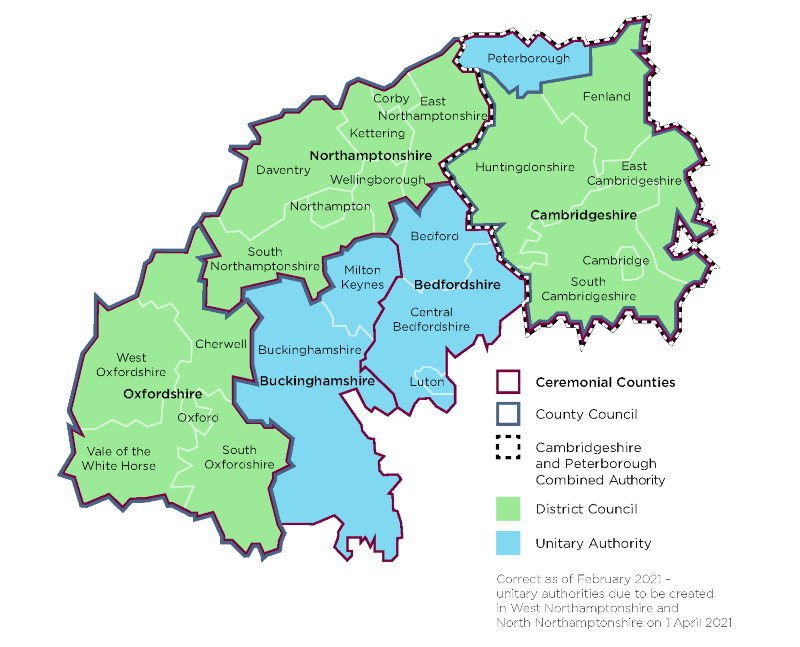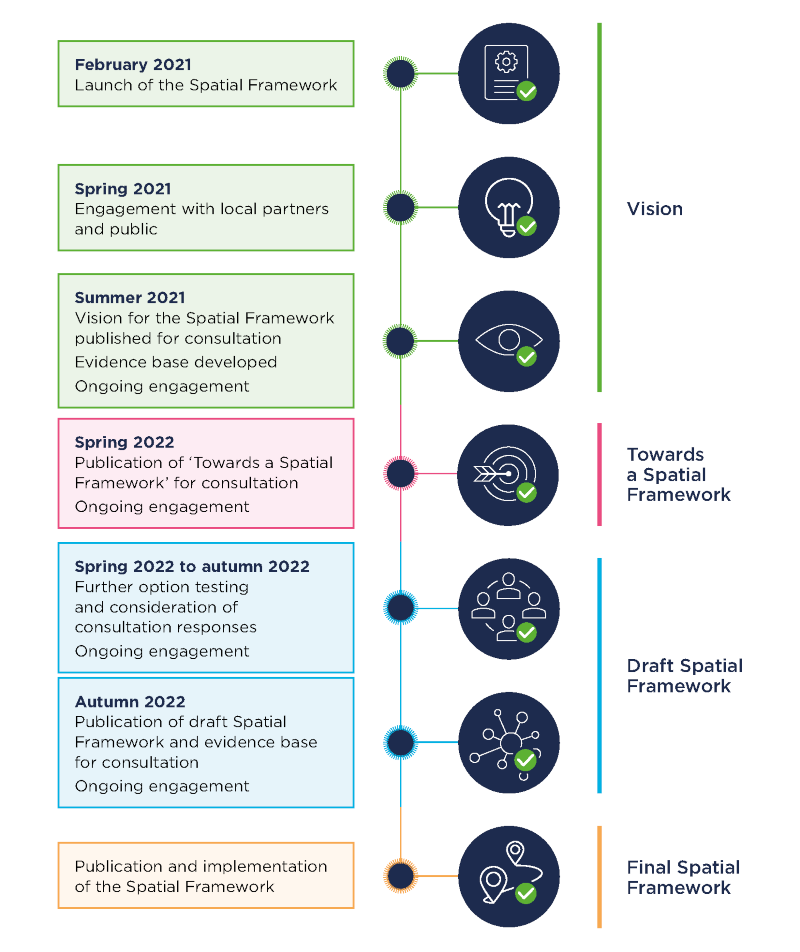Comment
Oxford – Cambridge Spatial Framework: A nationally significant Arc?
Nearly five years since the National Infrastructure Commission (NIC) was asked by the Treasury to look at how infrastructure development in the Cambridge-Milton Keynes-Oxford Arc can maximise the potential of the area, the Government has today finally published a policy paper “Planning for sustainable growth in the Oxford- Cambridge Arc: An introduction to the Oxford-Cambridge Arc Spatial Framework” for how the spatial framework for the Arc will be developed.
The full paper is available here.
Significantly, and indeed somewhat surprisingly, once implemented the Spatial Framework is to have national planning and transport policy status and will sit alongside the NPPF; rather than having Development Plan Status. The Government has stated that a sustainability appraisal will be developed to inform and underpin the preparation of the Spatial Framework. This will mean that greater weight is accorded to it in decision making, and ultimately greater certainty about the sustainability and deliverability of key attributes of the spatial plan. It perhaps announces a new dawn for strategic planning which could be rolled out elsewhere across the country.
It does however pose some local challenges. Given its impending status, we would question whether local authorities within the Arc will accelerate their plan production, when it is likely that any new Local Plan will not be adopted by the time the new Spatial Framework lands. These are all proceeding at different speeds but will need to have a relationship with the new Spatial Framework, given their life cycles are likely to be half the period of the Arc initiative.
We can therefore expect some necessary slowing down in plan-making in the Arc, albeit we would encourage local authorities to progress to the most advanced stage possible alongside this new process.
Although there is much detail still to follow, we have distilled the main points of the policy paper in a quick and easy summary which is presented below.

Arc timelines and coverage
The publication represents the first step in a two year process, with the intention for the final Spatial Framework to be implemented shortly after the consultation ends in autumn 2022. This finally represents a clear statement of intent from the Government which will ensure that the significant opportunities the Arc presents are delivered. It also recognises that in order to succeed this initiative needs to be planned for at a larger than local scale, and therefore it is necessary to find a new way of undertaking planning at the strategic level.
Notably, despite Buckinghamshire Council’s announcement in November 2020 that it had withdrawn from the Arc Leaders Group, the area remains within the remit of the Spatial Framework. It will be interesting to see how this sits with the Spatial Framework’s ambition to be developed collaboratively with local interests.

The proposed approach and status
In a positive and somewhat unique step, the proposed Spatial Framework will combine both transport and planning policy across the Arc. It will seemingly seek to draw on the ambitions of the Planning White Paper particularly in regard of data and digital tools in seeking to develop a Spatial Framework that is visual and map-based.
The establishment of a new Arc Growth Body is intended to provide a “clear economic leadership voice to the Arc”. The continued economic growth of the region is now even more vital as we build back better post-pandemic. As the report recognises, this must be 'good growth' and the commitment to wide-ranging consultation can help ensure that economic development, housing and infrastructure do not destroy the cherished built and natural heritage of the area. Clearly these opportunities and challenges will lead to much debate in the immediate future.
East West Rail and the Expressway – a road to nowhere, or no road at all?
A notable omission from the Spatial Framework is any reference to the previously proposed Expressway, although there is a clear recognition of the role the new East West Rail link is proposed to play.
Clearly the Framework will play an important role in the recently announced tender for an engagement strategy for new/expanded settlements around East West Rail Central Section stations which will run alongside work on the Spatial Framework.
What will it consider?
The Government has identified three areas of particular concern for the Spatial Framework to consider:
- the natural environment and climate change;
- connectivity and infrastructure; and
- the availability of homes where they are most needed.
Importantly, however, the consultation document also recognises the important role that the economic benefits of the Arc will also play in the development of the Spatial Framework.
The commitment to 'levelling up' will be welcomed by those authorities which have felt disconnected from the growth immediately around cities such as Cambridge, and will provide a real chance to tackle the inequalities which have developed. This is in contrast to the seemingly missed opportunity of the standard method in December 2020 which failed to include any cities or urban centres in the Arc for an uplift in their housing requirement.
Plan-making
With one of the core principles of the Spatial Framework proposed to be its long-term nature, with planning to 2050 and beyond, it is clear that previous commitments to the levels of growth will need to be readjusted to reflect the wider time horizon and ensure needs are truly met.
In Greater Cambridge, where a new Local Plan is building up to the 'preferred options' stage, the commitment to a quick timetable for the production of the Vision and Consultation Draft of the framework will be vital to the progress and success of the Local Plan, given the clear statement that these should continue to be developed alongside the Spatial Framework.
Given recent statements from authorities such as Milton Keynes advising that Local Plan preparation is to be put on hold, it will be interesting to see whether the proposed programme for the Spatial Framework gives sufficient certainty to these authorities to move forward with their Local Plans. At this moment in time, it is difficult to see how authorities in the Arc can do so with any certainty until the final Spatial Framework is released.
Climate crisis
The Paper includes strong indications of a positive approach to climate change mitigation and adaptation - aiming to align with the Government’s 25 Year Environment Plan, Net Zero commitments and Clean Growth Strategy. Given the symbiotic relationship of this topic with the other focus areas, it obviously needs particular and significant attention. Hopefully this will be forthcoming as the paper acknowledges that the need to ensure that the “environment underpins economic, transport and housing and planning decisions”!
Summary
Today’s publication is clearly just the first step in what needs to be an intensive process to ensure the programme is met, and the Government’s ambitions are finally to be delivered.
The Spatial Framework has a wide-ranging remit and recognises that if the Arc is going to be successful it must deliver in relation to the economy; the environment; transport and infrastructure; and housing and planning. By recognising the need for strategic planning, matters to can now be grappled with across the Arc, rather than being continually deferred for future consideration as per a number of recent Local Plan Examinations within the Arc.
The programme outlined provides a number of opportunities for engagement with the Spatial Framework and it will be important for a diverse range of stakeholders to engage in this process.

Whilst there is much to be positive about, we had hoped to see more detail, as called for in our article from March 2020. For example, there is still no Ministerial Champion for the Arc, nor certainty on delivery vehicles for new or expanded settlements. It is also somewhat surprising that the Arc has not been lined up as an exemplar for net zero and enhanced biodiversity improvements, given the opportunities that exist with development at this scale. Hopefully, more details on these elements will be forthcoming in the coming months.
Finally, with the Government’s clear ambitions for the Arc and how the Spatial Framework will be developed and delivered, it will be very interesting to see if this approach gets replicated elsewhere in the country, for example the large metropolitan areas in the North and Midlands, as part of the wider levelling up agenda.
This is a bold move by the Government, facing into some real challenges regarding ‘above local’ planning, and clearly reflecting on the contents of the Planning White Paper and failure of the Duty to Cooperate. This policy paper sets a course for the Arc to be nationally significant in its own right. If we learn from the process and apply this bold thinking elsewhere it could reflect a brave new dawn for planning in this country.
For more information on the Oxford to Cambridge Arc, please contact Donna Palmer or Tim Burden.
18 February 2021
Images and diagrams taken from Planning for sustainable growth in the Oxford-Cambridge Arc An introduction to the Oxford-Cambridge Arc Spatial Framework


